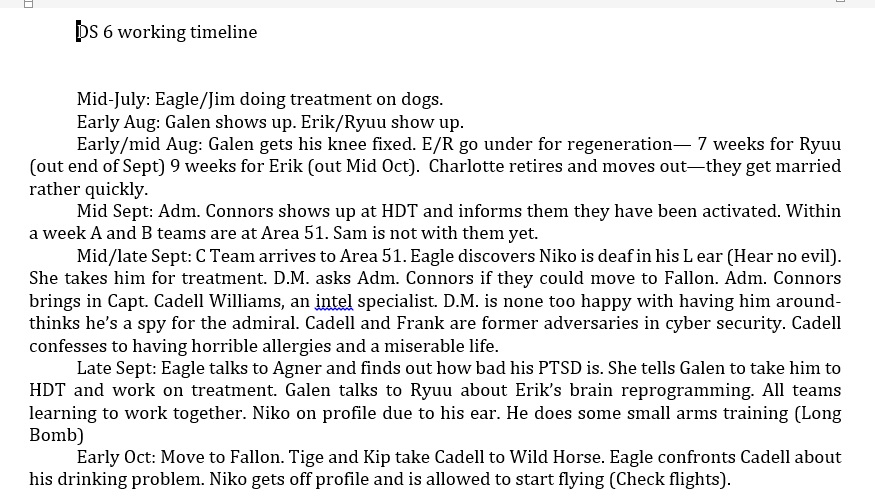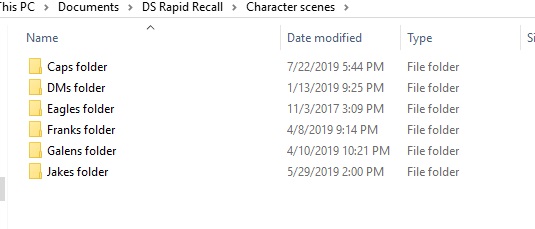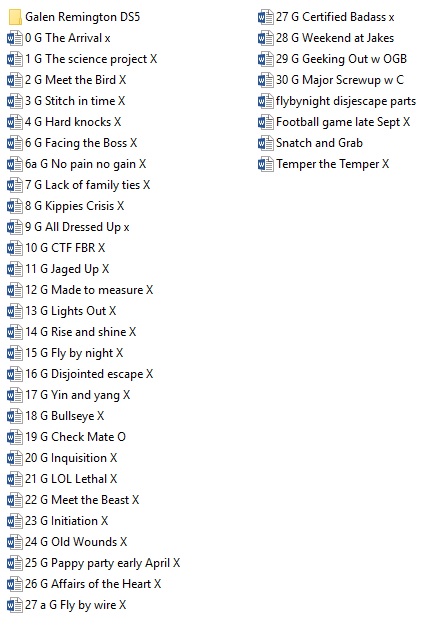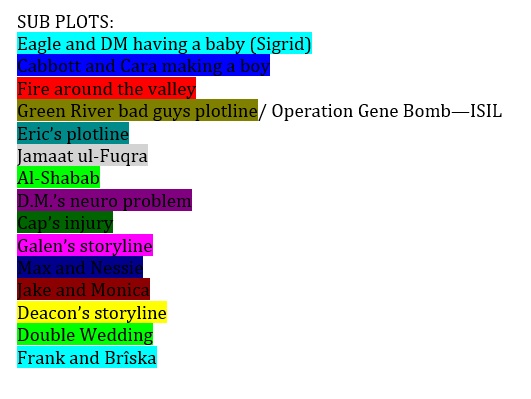 Writing is hard enough, and even harder when you’re really busy. How many times have you been doing something and a great scene pops into your head? It may have to deal with your current WIP (or sometimes even a sequel you haven’t thought about writing), or it may be a scene far toward the end of the book. Writers joke about the worst places inspiration can hit: the car, the shower, in a restaurant, out shopping, or the most common: in bed. If you’re like me, your characters are with you all the time — and sometimes it’s annoying. They sneak into your thoughts and create scenes that are amazing when you least expect it. Yeah, thanks, guys!
Writing is hard enough, and even harder when you’re really busy. How many times have you been doing something and a great scene pops into your head? It may have to deal with your current WIP (or sometimes even a sequel you haven’t thought about writing), or it may be a scene far toward the end of the book. Writers joke about the worst places inspiration can hit: the car, the shower, in a restaurant, out shopping, or the most common: in bed. If you’re like me, your characters are with you all the time — and sometimes it’s annoying. They sneak into your thoughts and create scenes that are amazing when you least expect it. Yeah, thanks, guys!
These fleeting scenes are the gold in your writing. They are raw, wild, and spontaneous. So what do you do about them? Most people think writing a book is a linear process. You start writing on page one of chapter one. Life may be linear, but the stuff going on in your head isn’t. Rarely have I found that a scene I wrote after it hit me like a ton of bricks was bad. The ones who tend to be bad are the forced scenes; the ones you write because you have to, not because they (your characters) want you to.
Sounding crazy? Maybe. But the inside of a writer’s mind is a world no one will ever understand. Everything is fleeting, and I mean everything. If you don’t write it down, even a rough synopsis, you’ll lose it. That fabulous scene will be gone for eternity.
I’m not one of those types who will wake up in the middle of the night, have this great scene in my head, and have to write it down. Yeah, I’ll wake up, but I won’t get out of my comfy bed or turn on the light to write anything. I try to remember the scene and copy it down later. Yes, I lose a lot of stellar material that way. The stuff I don’t lose goes on “paper” as soon as I can. Even if I can jot a few lines in the memo app on my cell phone, that helps jog my memory for later.
Once you have a pile of good scenes, how do you integrate them into your book? You undoubtedly have an outline of some sort (even if it’s in your head) and a plan of where you want the book to go. So where are you going to put the romantic marriage proposal? Or the valiant effort of a character to save the lives of his friends from a terrorist? These scenes may not have been part of your original plan, but they’re so good, you can’t leave them out. And in some respects, they help toward character development, so they’re needed.
My approach is somewhat of a controlled shotgun blast in the beginning. Using an initial timeline will help you figure out where you can start slotting in scenes to build the story. I try to keep scenes relating to a particular character in a folder for that character. That way, when I get inspired, all I need to do is create a new document and start writing. I try to number the scenes where I think they will need to take place in chronological order, but even sometimes that will change.
These are examples from my military thriller series, which is now going on its sixth book. Character and storyline continuity are of utmost importance when dealing with dozens of characters and hundreds of thousands of words over the course of books and years.



Once you start the overall construction of the book, a master timeline is very helpful — especially if it’s going to be a long and complicated story with numerous characters, plots, subplots, and chapters. No matter how careful you are, mistakes can happen. A timeline is a nice reference point to let you know where you are (and what your characters are doing) at a particular point in time during a chapter. I like to use a highlighter for my subplots, that way I can see the continuity of the storyline.
Don’t be afraid to let your mind go wild. Using these simple steps will help you organize those brilliant thoughts and scenes and help keep your story moving forward even when on occasion it seems to be moving sideways, backwards, and every direction but forward!





Other than that I keep my “files” almost exclusively in my head (perhaps to my detriment) much of what you say is similar for me. The best scenes are the ones that come easily and instantly. The others can be a struggle.
Great post.
If I tried to keep everything in my head, it would explode! I don’t just work on one novel at a time, sometimes 3-4 of them.
Hello, Kathy:
God, you’re organised. And a great post, too, on a subject that I think might not be well understood
For 20 years I carried a book around in my head – or versions of it. Then in June 2002 I sat down and started to write it. It was a story about a school rugby 1st XV and people associated with it.
My ‘start’ was that I wrote the end first because I knew what that was going to be. It’s all I knew.
That done – it took three weeks – I turned to write the start.
For two years I wrote back and forth because that’s how parts of the story kept occurring to me – 3am each day I woke up and there was the next part to write. Or it was in the shower. Invariably it had nothing to do with what I had written the day before or the week before or the chapter before. Even the year before.
Eventually it all tied together.
My second one – but the first I published – was entirely linear because when I started all I had was the first paragraph. Nothing else. I had no name, no characters, no story line. But for six months the next part of the story would wake me at 3am each day and I would have to scramble to write it.
I didn’t even know how to end it until a fortnight before I did.
Now I am on No 3, a more complicated thing, an alternative history that I’ve been plugging away at on-and-off for nearly 10 years. There is a story line, kind of, in my head but I have no idea how to finish it.
I’ve found that writing is individual, often solitary, and there is no ‘right’ way to do it.
‘Most people think writing a book is a linear process. You start writing on page one of chapter one. Life may be linear, but the stuff going on in your head isn’t. Rarely have I found that a scene I wrote after it hit me like a ton of bricks was bad. The ones who tend to be bad are the forced scenes; the ones you write because you have to, not because they (your characters) want you to.’
Well put. Thanks.
– Paul Corrigan
Thanks. I just can’t get up and write at 3 am. If I wake up, it’s tossin’ and turnin’ time until I convince myself to go back to sleep. And if something hits me at that awful hour, I try my best to hold it in my brain until I have time in the morning to write it down. The worst is when you have a character bugging you to write a great scene with them. Nope, no sleep…
Keep on writin’!
I love this! I have never written in order, unfortunately, and scenes come to me out of the blue like you expressed. I’ve also never been this organized, though, but I have used a big whiteboard to track timelines since they go across time zones which can be problematic, and I do use excel spreadsheets to keep my chapters straight. Thanks for inspiring me to do better. 🙂
With the Dragonslayer’s Saga, I HAVE to be organized! Currently 15 “main” characters, over a year in this book timeline (DS 5 part 1 and 2), and many mentions of events of the past (like who was pregnant when, and what happened?) so I have to keep organized or I create the evil “plot bunnies” that hop into the plotline and wreak havoc. Bunnies are cute, just not those.
The order has to come sometime, and if it tends to get in the way of writing the good scenes, then it has to come later.
The Texas Sharpshooter Fallacy is a psychological flaw in the human character that causes us to make emotional decisions and then pretend that the facts headed us that way all along. It involves a marksman who shoots a bunch of bullets at the barn, then puts a bulls-eye around the biggest group. Doesn’t work in psychology. Works great for story writing.
For my NaNo project this year I’m almost deliberately dipping in wherever. The ending was so clear I had to start there. I do have a scene list but I’m dipping in and not being linear at all, it feels the right way, because I have done some prep and have a road to travel…
Interesting view from the “other side.” I almost always write sequentially, and yes, some parts do end up forced, but I fix those in revision. My wife’s approach is more like yours, all over the place. I have, however, had an occasional scene attack, and when I do, I go with it. I wrote the final scene of my third Howard County Mystery, “Ice on the Bay,” that way. The interesting things was, it gave me something to aim for. I think that helped in developing the lead-up to the end.